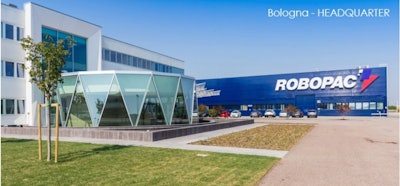
Founded in 2001, secondary packaging provider Robopac USA is based in Duluth, Georgia, but it has deep roots in the packaging valley of Bologna, Italy. As a subsidiary of the Italian-based Aetna Group that started as a foundry casting aluminum in the 1930s, the company is built on a customer-centric partnership approach, delivering the end-of-line packaging equipment needed downstream to pack cases and stack pallets.
Robopac USA is best known for its portable semi-automatic stretch wrap machine, called Robot S7, now in its seventh generation, but the company offers everything downstream from the product being made. Once the product is filled, it needs to be case packed and stacked onto a pallet and then picked up to be taken to the truck to be loaded.
“We manufacture, service, and support a complete line of end-of-line packaging equipment,” said Robopac USA marketing manager Derek Jones, noting the company provides the widest range of machines and technological capabilities across all of its product lines, including case packing, palletizing, stretch wrapping, and laser guided vehicles.
Customizable machines
Most of the case packing, stretch wrapping and laser guided vehicles are manufactured in Italy, but Robopac USA does have facilities in Portland, Oregon where palletizing equipment and entry level automatic stretch wrappers (LT Automatic) are made. In addition, on semi-automatic stretch wrapping side of the business, they keep around 250-300 of those machines in stock to keep lead times short. “Most semi-automatic stretch wrappers ship within 72 hours from receipt of the purchase order. Robopac also has over $2 million in spare parts with over 90% shipping the same day,” Jones said. Derek Jones, Robopac USA Marketing ManagerRobopac USA
Derek Jones, Robopac USA Marketing ManagerRobopac USA
And, the equipment is designed to be adaptable. For example, while its semi-automatic stretch wrapping equipment comes in different configurations, if a customer wants to add on capabilities, like roping devices, Robopac is able to upgrade the equipment at its Georgia facility prior to shipping. In addition, the machines that go through an RFQ process—including case packing, palletizing, automatic stretch wrapping, and laser guided vehicles—can be customized based on end user requirements.
This level of flexibility coupled with an increased demand for more automated end-of-line equipment due to a labor shortage in the industry, is why Robopac USA has experienced 30% to 40% revenue growth every year in the North American market over the past four years.
The company also continues to evolve its products, as Robopac invests over 6% of revenues annually into research and development. “New product development is often a matter of designing new options to fit a particular market need,” Jones said. “Oftentimes, our customers come to us with new primary packaging designs which require adaptations of our equipment to meet those needs. If these new product designs are believed to be a market trend, the Robopac engineering team will start developing these adaptations.”
Other times, it is a matter of listening to the voice of the customer, many of which are asking Robopac to make the machines more user friendly. For example, more people want “hands off” experiences with the machines, but the automatic stretch wrappers would require someone to change the roll. As a result, the company created an automatic roll changing (ARC) device that can detect when the film has run out. It then automatically switches the roll itself and when another load comes down the conveyor and enters the wrapping zone, it will trigger the photo eye sensor and the machine will start back up and wrap another load.
Meeting market changes
There are other trends in the CPG industry currently happening around changes in shelf-ready packaging and materials that are impacting how Robopac is designing its machines.
 Rodney Grounds, Vice President of Sales at Robopac USARobopac USA
Rodney Grounds, Vice President of Sales at Robopac USARobopac USA
Shelf-ready packaging is driven by the labor shortage in retail where there is a need for more efficiency in the stocking of products on the store shelves. “Robopac has worked with corrugate manufacturers to come up with unique wrap-around case designs that provide a shelf-ready solution,” said Rodney Grounds, Vice President of Sales at Robopac USA. “Because the cases are designed as a wrap-around, our customers will see a reduction in corrugate use over traditional shelf-ready case designs. Typically, a customer can reduce the corrugate by 5-to-7% using this method.”
Another trend Grounds is seeing from the large consumer products companies is the reduction of plastics in their packaging materials. By using Robopac’s patented Cube film delivery system, they have consistently been able to show a 20-to-50% reduction in stretch film consumption while maintaining superior load containment, he said. “Since stretch film is one of the most difficult materials to recycle, the reduction of stretch film on a pallet allows companies to reduce plastic from the waste stream while at the same time saving money related to the decreased amount of stretch film needed for shipments.”
In addition, Robopac is on its own digital transformation path, using a stage-gate approach to new product development. One of the stages includes the use of digital twins, which allows engineers to simulate new product development to ensure the legitimacy of the prototype. But that is just one way the technology could potentially be used. “Robopac sees that in the future digital twins could be used as an artificial intelligence platform for maintenance and repair,” said Grounds.
The glo-cal advantage
Because this US-based company is headquartered in Italy, there is a cross-culture influence. For example, Robopac USA has an Italian CEO that provides a nice balance of the Italian culture with the US expectations around speed and service.
“We use a term called ‘glo-cal,’ that is global and local, a combination of how we want to present ourselves as an organization around the world, but also understanding that each market is different and we need to know what the needs are of the local area,” Jones said. The Prasmatic TC 500 combined shrink-wrapper and case packer for medium to high-speed productions.Robopac USA
The Prasmatic TC 500 combined shrink-wrapper and case packer for medium to high-speed productions.Robopac USA
To that end, the company believes it is important to be present in the customers’ local markets, therefore they have regional sales engineers based geographically in North America. These sales engineers are assisted by a team of application engineers each specializing in an equipment sector. In addition, each global business unit has a team of specialized project managers to make sure local customers are served properly.
This commitment to customers has been an important part of the company’s Italian history, and it will also lead the North American operations into the future as it continues to grow and expand operations.















